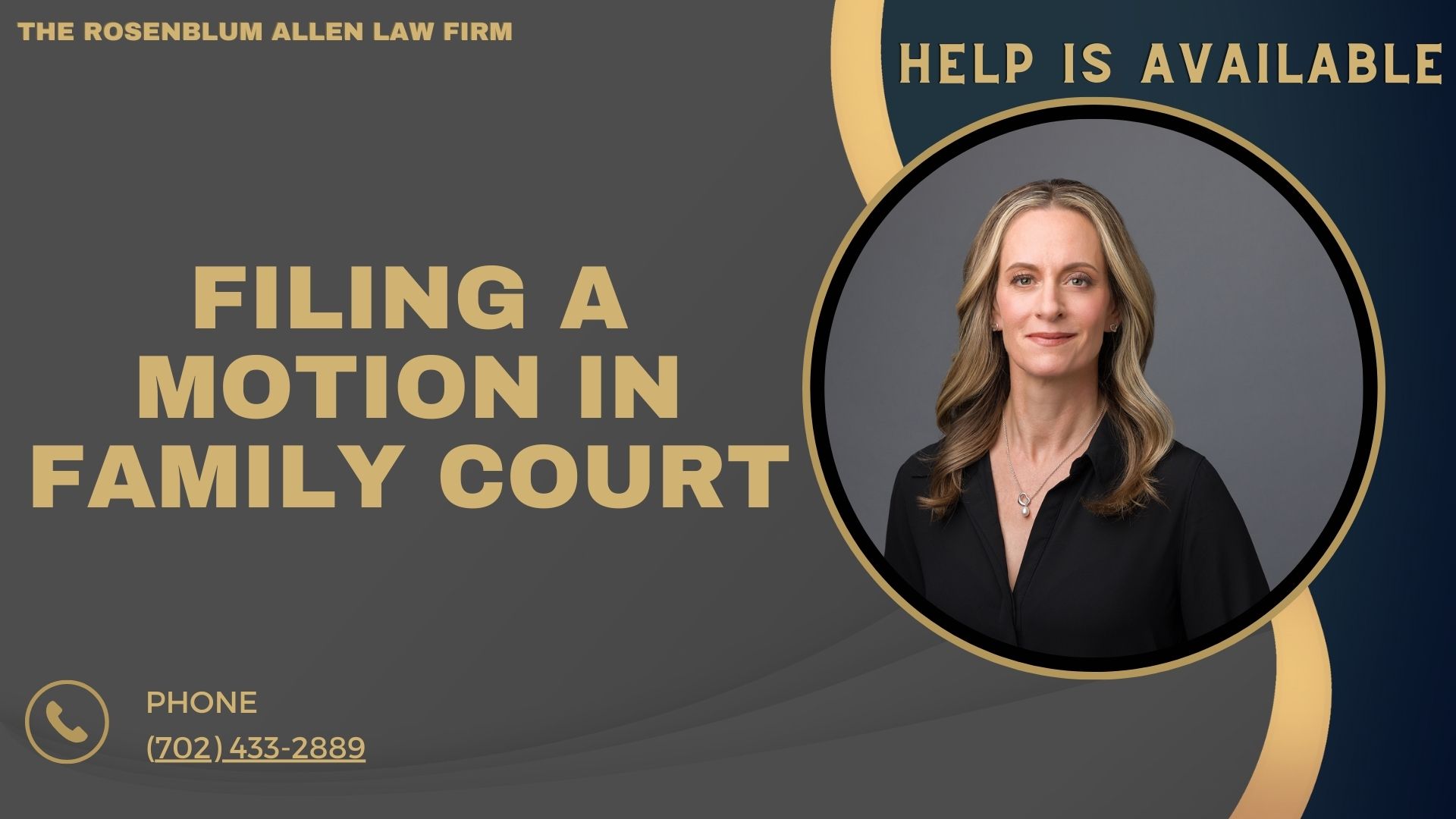Definition and Purpose
A motion is simply a formal request you file with the court, asking for something to happen in your case. The court might decide to:- Change an existing order (like custody or visitation).
- Enforce an order (if one party isn’t following it).
- Create a temporary order (while waiting for a final decision).
Common Types of Motions
Understanding the type of motion you need is critical. Here are the most common ones:Modification of Custody or Support
If your situation changes—like losing a job or moving—you may want to ask the court to modify child custody or support orders.Enforcement of Existing Orders
If the other party isn’t following a court order, such as refusing visitation or not paying child support, you can file a motion to enforce that order.Temporary Orders
Sometimes, you need an immediate decision while your case is still open. For example, you might need a temporary custody arrangement while waiting for the final ruling.Preparing to File a Motion in Family Court
Before filing, it’s essential to be well-prepared. Planning can save time and make the process easier.Identifying the Correct Motion
First, make sure you’re filing the proper motion. Is your goal to change an existing order? Or enforce a current one? Identify what you’re asking the court to do so you file the correct paperwork.Reviewing Court Rules and Procedures
Each court may have its own rules about filing motions. Some courts require certain forms or specific wording. Take the time to read up on local regulations to avoid issues later.Gathering Required Information
Having all your documents ready makes the process smoother. Here’s what you’ll typically need:Case Numbers and Relevant Orders
Make sure you have your case number handy. You’ll also need copies of any court orders you ask to change or enforce.Evidence to Support Your Motion
You’ll need to back up your request with proof. For example, if you’re asking to modify child support because you lost your job, bring documents that show your current income.
Drafting the Motion
Writing your motion doesn’t have to be overly complicated. It’s about being transparent, direct, and including the correct details.Key Elements to Include
Make sure your motion contains the following:Case Information
Start with essential information like the parties’ names and your case number. Courts need this to process your paperwork.Legal Arguments
This is where you explain what you want and why. It’s important to be specific. For example, if you wish for a custody change, explain what has changed in your life that justifies this request.Specific Request for Relief
Make sure to state what you’re asking the court to do clearly. For example, “I am requesting a change in the custody schedule to allow me to have the children every other weekend.”Supporting Documents
You’ll also need to attach evidence that supports your motion. This is where you build your case.Affidavits
An affidavit is a sworn statement. You can include one from yourself or others who can testify to the facts that support your motion.Financial Records and Other Evidence
Include things like pay stubs, text messages, or emails—anything that helps explain why the court should grant your motion.Filing the Motion with the Court
Once your motion is written and your documents are ready, it’s time to file it.Submitting Your Motion
You have two main options for submitting your motion: in person or electronically (if your court allows online filing).Online vs. In-Person Filing
Some courts let you file electronically through their website, which is fast and convenient. If not, you’ll need to file in person at the courthouse.Court Fees and Waivers
There’s usually a fee to file a motion, but you can apply for a fee waiver if you can’t afford it. Check your court’s rules for how to apply.Serving the Other Party
After filing, you need to notify the other party. This is called “service of process.”Who Can Serve the Documents
You can’t do this yourself. Instead, a third party—like a process server or the sheriff—must deliver the papers.Methods of Service
Here are the common ways to serve the other party:- Personal service: Delivered directly to the other party.
- Service by mail: Sent through certified or registered mail, depending on your court’s rules.
- Service by publication: Used only if you cannot find the other party (requires court approval).

After Filing the Motion
Your work isn’t done once you’ve filed your motion and served the other party. The court will review your request, and a hearing might be scheduled. Here’s what to expect.Responding to Opposing Motions
The other party may file their motion in response to yours. This is common in family court cases. If they do, you’ll need to review it carefully.- Please read it thoroughly: Understand what they are asking for.
- Gather evidence: If you disagree with their motion, start collecting evidence to refute it.
- File a response: Courts usually give you a deadline to respond. Don’t miss it.
Preparing for the Hearing
If your case involves a hearing, this is your chance to present your case to the judge. You’ll want to be well-prepared.What to Expect During the Hearing
The hearing is where you and the other party will each explain your side. The judge will ask questions, and both sides will have a chance to present evidence and witnesses.- Be on time: Plan to arrive early.
- Dress appropriately: Court is formal, so wear business attire.
- Stay calm: Speak clearly and stick to the facts.
Presenting Your Evidence and Argument
You’ll need to present the same documents and evidence that you attached to your motion. Here are a few tips for presenting them effectively:- Organize your papers: Keep everything neat so you can find what you need quickly.
- Be concise: Judges appreciate when you get to the point without rambling.
- Answer the judge’s questions directly: If the judge asks you something, respond with clear answers. Don’t guess.

After the Hearing
Once the hearing is over, the court will make a decision. Here’s what happens next.Receiving the Court’s Decision
After the hearing, the judge will issue a ruling. This might happen immediately in court or later in writing.- Pay attention: If the ruling is given in court, take notes so you remember exactly what the judge orders.
- Wait for official documents: The court will issue an official order, which you must follow closely.
Understanding the Judge’s Ruling
The ruling will explain what happens next. For example, if it’s a custody modification, it will detail the new schedule. Please read it carefully to make sure you fully understand what’s expected.What to Do If the Motion is Granted
Suppose the judge grants your motion, great! But there are still steps you need to take.- Implement the court’s orders: Start following the new rules immediately.
- Notify the other party: If needed, remind the other party about the new order, such as a custody change or payment adjustment.
Requesting Clarification of the Court’s Ruling
Sometimes, a court order might need to be clarified. If you need clarification about any part of it, you can file a motion asking the court to define the order.What to Do If the Motion is Denied
If the judge denies your motion, you still have options.- File for reconsideration: This is where you ask the judge to review the decision. You’ll need to provide a strong reason, such as new evidence.
- Appeal the decision: You can sometimes appeal, but this process is more complex. It’s often best to get legal advice if you’re considering an appeal.
Additional Considerations for Filing a Motion in Family Court
While the steps for filing a motion are fairly straightforward, there are some additional factors to consider.Working with an Attorney vs. Filing Pro Se (Self-Representation)
When filing a motion, you can either represent yourself or hire a lawyer. Both options have pros and cons.- Hiring an attorney: An experienced family law attorney can guide you through the process and represent you in court. They know how to craft arguments that the court will take seriously.
- Representing yourself: If you can’t afford an attorney or feel comfortable handling the paperwork, you can represent yourself (pro se). Just make sure to research the rules and stay organized.
Resources for Representing Yourself
If you choose to represent yourself, many courts offer self-help resources. These can include:- Online guides
- Legal forms
- In-person help desks at the courthouse
Court-Specific Rules and Procedures
Different courts have different rules. Always check the specific requirements for the court handling your case.- Filing deadlines: You must complete a deadline to ensure your case is successful.
- Court forms: Some courts require specific forms, so ensure you use the correct ones.
- Local rules: Familiarize yourself with your court’s local rules, which can impact how your case is handled.
Researching Applicable State Laws
Family court cases vary by state. Nevada, for example, has specific laws for custody, child support, and spousal support. Ensure you’re familiar with the laws in your state so you can tailor your motion appropriately.Legal Aid and Low-Cost Services for Filing Motions
If money is tight, you can still get help filing your motion. Many legal aid organizations offer free or low-cost services to people who can’t afford a private attorney.- Legal aid offices: These organizations provide free legal help for low-income individuals.
- Self-help centers: Some courts have staff available to assist you with paperwork and basic legal questions.
- Pro bono attorneys: In some cases, attorneys will work for free (pro bono) on cases where clients cannot afford representation.

Common Mistakes to Avoid When Filing a Motion
Avoiding simple mistakes can save you time, money, and frustration. Here are the most common pitfalls people face when filing a motion.Filing the Wrong Type of Motion
It’s easy to get confused about which motion to file. Make sure your motion is appropriate for your request. Filing the wrong type of motion can lead to delays or outright denial.Failing to Meet Deadlines
Courts are strict about deadlines. Missing one can mean your motion won’t be heard. Stay organized by keeping track of all critical dates in a calendar.Submitting Incomplete or Incorrect Information
Double-check everything before you submit your motion. Please include pages or correct information to avoid unnecessary delays.Neglecting to Serve the Other Party Properly
Service of process is critical. The court won’t hear your case if the other party isn’t properly served. Ensure you follow the service rules carefully and always file proof of service with the court. Filing a motion in family court may seem overwhelming, but understanding the process makes it more manageable. Each step is crucial, from choosing the proper motion to preparing your evidence. Take the time to familiarize yourself with your court’s rules, stay organized, and be thorough with your paperwork. Being informed puts you in a stronger position whether you represent yourself or work with an attorney. If the judge grants your motion, follow the new orders carefully. If denied, remember you may have options like reconsideration or appeal. The key is staying patient and persistent, knowing that family court decisions can significantly impact your life and the lives of your loved ones.
Frequently Asked Questions
How long does it take for a judge to rule on a motion?
The timeline for a judge to rule on a motion can vary depending on the court’s schedule and the complexity of the case. Some motions are decided quickly, especially if they are straightforward or urgent. Others might take longer, especially if a hearing is required. Typically, you can expect a few weeks, but it’s best to check with the court for a more specific timeframe.
Can I change my motion after it’s filed?
Yes, in some cases, you can amend or modify your motion after filing it, but you’ll need to do so before the hearing. It’s important to act quickly and follow the court’s procedures for filing amended motions. Keep in mind that the other party must also be notified of any changes.
What happens if the other party doesn’t respond to my motion?
If the other party doesn’t respond within the given time, the court may grant your motion by default. This means the judge could rule in your favor without hearing the other party’s arguments. However, the court may also request a hearing before making a final decision.
Do I need to attend the hearing for my motion?
Yes, it’s important to attend the hearing. Failing to show up can result in your motion being denied or delayed. If you have a legitimate reason for missing the hearing, such as an emergency, notify the court as soon as possible to avoid complications.
Can I withdraw my motion after filing it?
Yes, you can withdraw your motion before the court makes a decision. You’ll need to notify both the court and the other party in writing that you wish to withdraw the motion. Keep in mind that once withdrawn, you may not be able to refile the same motion without new evidence or circumstances.
Will the judge make a decision at the hearing?
In some cases, the judge may issue a ruling immediately after the hearing. However, if the case is complex or additional information is needed, the judge may take the matter under advisement and issue a written decision later.
What if I disagree with the judge’s decision?
If you disagree with the judge’s decision, you may have the option to file a motion for reconsideration or appeal the ruling. This must be done within a specific time frame, and it’s important to consult the court’s rules or seek legal advice to determine the best course of action.
Can I file multiple motions at the same time?
Yes, you can file more than one motion at the same time, but they should be related to the same case. For example, you could file a motion to modify custody and a motion to enforce a child support order. Be sure to clearly label and explain each motion separately.
Is it possible to settle without a hearing?
Yes, it’s possible to settle the issue with the other party before the hearing. If you and the other party reach an agreement, you can submit a stipulation to the court, and the judge can approve it without a formal hearing. This can save time and reduce legal costs.
What should I do if I can’t afford the court fees?
If you can’t afford the fees to file your motion, you can apply for a fee waiver. The court will review your financial situation and determine whether you qualify for a waiver. Most courts have forms available online or at the courthouse for this purpose.

Additional Resources for You
Molly Rosenblum, Esq., our distinguished lead attorney, not only provides exceptional legal representation but also offers a wealth of resources to support you through various family law matters. Understanding the complexities and emotional challenges of family law, these resources are meticulously crafted to offer guidance, clarity, and support during these critical times. Here’s a highlight of the valuable resources available at your disposal:
Las Vegas Family Law Attorneys: Navigate the complexities of family law in Las Vegas with effective advice and representation, ensuring your interests are protected every step of the way. Explore the resource.
Family Court Las Vegas: Gain insights into the family court system in Las Vegas, and learn how to effectively navigate the legal proceedings. Learn more.
Common Law Marriage in Nevada: Understand the legal standing of common-law marriage in Nevada and how it may impact your relationship and rights. Read the details.
Name Change Las Vegas: Whether due to marriage, divorce, or personal choice, find out the legal process for changing your name in Las Vegas. Start the process.
Nevada Power of Attorney: Discover how to legally empower someone to make important decisions on your behalf with a power of attorney. Understand the specifics.
Family Court Mediation: Explore the process of family court mediation as a way to resolve disputes amicably and effectively. Understand mediation.
Unbundled Attorney: Learn about the option of unbundled legal services, allowing you to hire an attorney for specific parts of your case, potentially saving time and resources. Explore the option.
Nevada Adoption: Understand the legal process of adoption in Nevada, and find out how to navigate the journey to expanding your family. Read about adoption.
Molly Rosenblum, Esq., is committed to providing not just legal services but also comprehensive support through these well-researched resources. Whether you’re dealing with the nuances of family law, navigating court procedures, or understanding legal options, these resources are designed to assist you in your journey. We encourage you to utilize these valuable tools to make informed decisions during these significant life events.

Offsite Resources You May Find Helpful
Here are seven offsite resources that provide information about filing a motion in a family court case:
FindLaw: This online resource provides free legal information, a lawyer directory, and other resources on a wide range of legal topics, including family law and procedures for filing motions in court.
Justia: Justia offers free legal information and a directory of attorneys for various legal issues, including how to file a motion in a family court case.
Nolo: Nolo provides legal information to consumers and small businesses, including articles, blogs, FAQs, and news on how to file a motion in family court.
American Bar Association: The ABA provides a variety of resources on legal topics, including information on family court procedures and how to file a motion.
Avvo: This website provides a directory of lawyers, legal advice, and other resources on a broad range of legal topics, including how to file a motion in family court.
LegalMatch: This online legal matching service helps individuals find lawyers in their area and provides advice and resources on family law matters, including filing a motion in court.
LawHelp.org: LawHelp.org offers free legal help for individuals with low income, and provides resources and information on a variety of legal topics, including how to file a motion in a family court case.

A Special Message from Our Lead Attorney

Molly Rosenblum, Esq
Thank you for taking the time to read through this helpful guide on filing motions in family court.
I know these legal processes can be confusing and frustrating to navigate, especially when you’re dealing with a difficult co-parenting relationship.
At my law firm, we have extensive experience handling contested divorces, custody disputes, and complex family law matters.
My team and I are always ready to listen and provide the knowledgeable legal counsel you deserve during this challenging time.
If you feel your case could benefit from experienced representation as you file motions and go through the court process, please give me a call at (702) 433-2889 to discuss your situation.
I would be happy to talk through your options.
Wishing you the very best as you move forward.




